Eduard 1/32 Bf-109E-1
|
KIT #: |
3001 |
|
PRICE: |
$74.95 SRP
|
|
DECALS: |
Four Options |
|
REVIEWER: |
Tom Cleaver |
|
NOTES: |
Cutting Edge Bf-109E resin cockpit and
EagleCals EC122 decals used. |

The Bf-109E series was developed in 1938, to take advantage of the DB
600-series engine, which gave the aircraft a performance enhancement of 50
percent over the previous Jumo-powered sub-types.
Most importantly, the DB 601A had direct fuel injection rather than a
carburetor, so that negative-g maneuvers presented no problem and allowed the
airplane to out-dive adversaries such as the Spitfire or Hurricane that were
equipped with float-type carburetors.
The first true Bf-109E prototype was the Bf-109V 15, powered by the DB
601A-1 rated at 1,050 h.p. With the engine proven during tests in 1938, the
Bf-109E-1 was approved for production in late 1938, armed with four 7.62mm
machine guns, and began rolling off the production lines in January 1939 at the
Regensburg
plant. As originally produced, the
Bf-109E-1 provided no armor protection for the pilot, though later during the
Battle
of
Britain
pilots did attach armored headrests from the Bf-109E-3 and some had the external
armored windscreen. 1,183
Bf-109E-1s were built during 1939, with production tapering off in 1940.
Operationally, the lightweight Bf-109E-1 was generally flown by junior
enlisted men serving as wingmen to flight leaders in the cannon-armed Bf-109E-3.
Appearing in the squadrons in February, 1939, the Bf-109E-1 was also
simultaneously sent to Jagdgruppe 88 of the Legion Condor in Spain, with
2/ Staffel converting from the Bf-109B in late February/early March 1939, just
prior to the end of the Civil War.
These Bf-109E-1s were provided only after the Franco g overnment
had agreed to allow German companies to participate in Spanish iron ore mining,
and would remain in service with the Ejercito del Aire until the early
1950s. In Luftwaffe service,
the Bf-109E-1 soldiered on until late 1942 on the Eastern Front after being
modified as a Jagdbomber.
overnment
had agreed to allow German companies to participate in Spanish iron ore mining,
and would remain in service with the Ejercito del Aire until the early
1950s. In Luftwaffe service,
the Bf-109E-1 soldiered on until late 1942 on the Eastern Front after being
modified as a Jagdbomber.
JG 52 On the Western Front:
Jagdgeschwader 52 would become the most successful Luftwaffe
fighter wing of the Second World War, and the most successful fighter wing of
any air force in history, with a
claimed total in excess of 10,000 victories over enemy aircraft.
The three top-scoring Experten of the Luftwaffe (and of
history) - Erich Hartmann, Gerhard Barkhorn and Günther Rall, - flew with JG 52,
which was exclusively equipped with various sub-types of the Messerschmitt
Bf-109 throughout the war.
Interestingly enough, JG 52 was not considered a top unit until transferred to
the Eastern Front to take part in Operation Barbarossa, the invasion of
the
Soviet Union.
Initially, JG 52 was a two-Gruppe unit, whereas most
JagdGeschwadern were three-Gruppe units. The unit’s achievements
during the offensives in the West and the later
Battle
of
Britain
were rather unremarkable. By the end of 1940, JG 52 had only 177 claims and had
suffered high losses with 53 pilots killed or made POWs during the
Battle
of
Britain.
One of the pilots in JG 52 during this period who would go on to an
outstanding career as a fighter pilot was Johannes “Macky” Steinhoff, who came
to the unit a few months before the opening of the offensive in the West, as
Staffelkapitän of 4./JG 52.
Born
September 15, 1913
in Bottendorf,
Thuringia,
Steinhoff was the son of a millworker.
In the early 1930s, he studied to become a teacher at the
University
of
Jena.
Unable to find a job, he joined the Kriegsmarine, where he served
a year as a naval flying cadet before transferring to the Luftwaffe in 1935.
Upon completion of his training, he was posted to JG 132, which would later
become JG 26.
Steinhoff was one of the Luftwaffe pilots who intercepted the RAF
armed reconnaissance of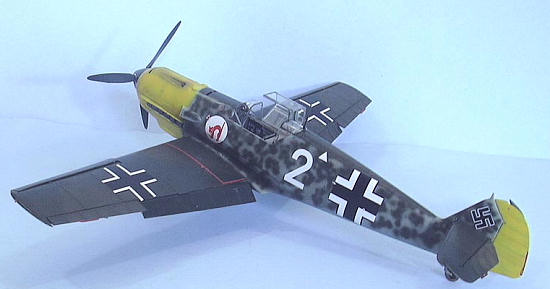 the Heligoland Bight on
December 18, 1939,
an action that convinced the RAF they could not operate unescorted bombers in
German airspace in daylight.
Shortly after, he was promoted to Staffelkapitän of 10./JG 26. In
February 1940, he transferred to 4./JG 52 which he led in both the French
campaign and the
Battle
of
Britain.
By the end of the
Battle
of
Britain,
Steinhoff had claimed six victories.
the Heligoland Bight on
December 18, 1939,
an action that convinced the RAF they could not operate unescorted bombers in
German airspace in daylight.
Shortly after, he was promoted to Staffelkapitän of 10./JG 26. In
February 1940, he transferred to 4./JG 52 which he led in both the French
campaign and the
Battle
of
Britain.
By the end of the
Battle
of
Britain,
Steinhoff had claimed six victories.
Over the course of a combat career that lasted
until the final weeks of the war when he was badly injured and burned in the
crash of an Me-262, Steinhoff claimed 176 aircraft destroyed, of which 152 were
on the Eastern front, 12 on the Western front and 12 in the Mediterranean, over
the course of 993 operational sorties. During the war, Steinhoff was shot down
12 times, but bailed out only once.
During the
Battle
of
Britain,
Steinhoff’s faithful wingman was Feldwebel Paul Boche, who scored a
single victory - an M.S.405 - on May 15, 1940.
Throughout his career with the wartime Luftwaffe and the post-war
Bundesluftwaffe, Steinhoff’s great strength was his ability to pass on
his knowledge and training to novice pilots, thus equipping them with the skills
to survive and ultimately become experienced fighter pilots.
In the 1970s, as Chief of Staff of the Bundesluftwaffe, Steinhoff
designed a more complete pilot training program that cut down the horrendous
accident rate in the F-104G dramatically.
Steinhoff played a major but little-known role in the controversial 1985
visit of President Ronald Reagan to
Kolmeshöhe
Cemetery
near Bitburg, which had been planned as an act of reconciliation for the 40th
anniversary of V-E Day that week.
Shortly before the event, it was discovered that 22 Waffen-SS were buried
among the 2,000 German Army graves military internments, which led to a public
outcry over the visit from Jewish groups and World War II American veterans,
inasmuch as the wreath-laying was to follow a visit by Reagan and Chancellor
Helmuth Kohl to the Bergen-Belsen concentration camp.
Reagan was accompanied by General Matthew Ridgway, who had commanded the
82nd Airborne in World War II, and General Steinhoff.
After the President placed a wreath at the wall of remembrance in the
cemetery, Steinhoff turned, and in an unscripted act, shook hands firmly with
Ridgway in a true act of reconciliation. Reagan smiled, and firmly shook
Steinhoff’s hand, while a shocked Kohl later thanked his General, who said that
it just seemed the right thing to do.
Eduard’s long-awaited Bf-109E-1 is the first completely-accurate kit of
the best-known sub-type of
Germany’s
most famous fighter of the Second World War.
The kit provides 169 parts in olive colored plastic, with five clear
parts, two photo-etched frets including one in color, canopy masks, and markings
for four aircraft plus full stencil data.
The parts are crisply molded with fine recessed panel line detail and
rivets in various places where it is correct to see them.
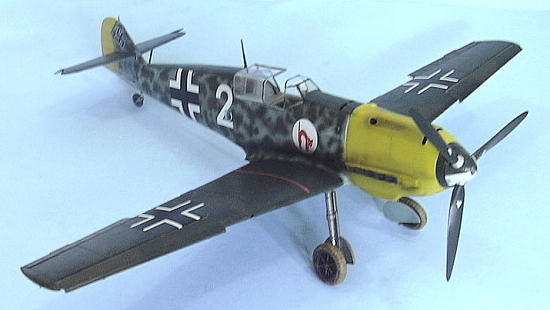 At the time the kit was released, several modelers at different forums
wondered whether the very nice Cutting Edge resin cockpit that had been created
to correct the old Hasegawa Bf-109E could be used on this new kit.
As the possessor of two of these sets, I decided to check that out and
see what the answer might be.
At the time the kit was released, several modelers at different forums
wondered whether the very nice Cutting Edge resin cockpit that had been created
to correct the old Hasegawa Bf-109E could be used on this new kit.
As the possessor of two of these sets, I decided to check that out and
see what the answer might be.
The quick answer is yes, it can be used and does fit easily, but it is
not really as accurate as it appears, since it was made for the old Hasegawa kit
and its many inaccuracies. That
said, it is a nicer, more detailed, busier cockpit than what comes with the kit,
and the seat - especially if you got the seat with the molded-in back pad and
seat belts - does make up into a much nicer looking seat than what you can do
with the kit. This is not to slam
the kit cockpit, which can be turned into something really nice with only a
modicum of effort using the photoetch detail.
The big inaccuracy of the Cutting Edge cockpit is that the rear cockpit
bulkhead does not rake back at a sharp enough angle.
However, after looking it over, I decided to use it on this kit to show
what can be done using it. I’ll
note that once you have the cockpit in place and the fuselage assembled with the
seat in position, you can’t really notice that incorrect rear bulkhead.
Thus, a modeler who bought that set from Cutting Edge can finally put it
to use in this kit.
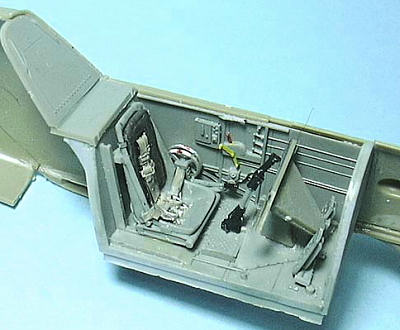 Having made that determination, assembly started with the cockpit, as
they say. I painted the Cutting
Edge parts with Xtracrylix RLM02, and detailed them.
For the seat, I used Xtracrylix RLM81 Braunviolett for the leather pad,
and
Xtracrylix
Gulf
Armour Tan for the seatbelts, enhancing everything with a wash of Tamiya “smoke”
to pop out detail and then giving the parts a coat of Xtracrylix Flat Varnish.
I used as much of the Eduard photoetch as possible to enhance the nice
detail in the Cutting Edge cockpit, with the photoetch instrument panel and all
the various wires for the trim wheels and such. I only had to cut off the
locating pins on the fuselage halves for everything to fit perfectly.
Having made that determination, assembly started with the cockpit, as
they say. I painted the Cutting
Edge parts with Xtracrylix RLM02, and detailed them.
For the seat, I used Xtracrylix RLM81 Braunviolett for the leather pad,
and
Xtracrylix
Gulf
Armour Tan for the seatbelts, enhancing everything with a wash of Tamiya “smoke”
to pop out detail and then giving the parts a coat of Xtracrylix Flat Varnish.
I used as much of the Eduard photoetch as possible to enhance the nice
detail in the Cutting Edge cockpit, with the photoetch instrument panel and all
the various wires for the trim wheels and such. I only had to cut off the
locating pins on the fuselage halves for everything to fit perfectly.
I decided I didn’t want to do the engine, so I followed the instructions
for attaching the exhaust stubs to their backplate, and closed up the engine
cowling.
The wing assembled easily.
The instructions would have the wheel wells aluminum, but they should be RLM02
with the walls of the wheel wells in leather brown.
I used Xtracrylix for these colors, popping out detail with Tamiya
“Smoke.” I left off the leading
edge slats and aileron mass balances for later assembly, and attached the flaps
in down position with the ailerons “balanced” to go along with the sit of the
control stick in the cockpit. The
horizontal stabilizers were assembled with the elevators drooped.
Painting:
The summer of 1940 was a time of experimentation for Luftwaffe fighter
camouflage, with some really interesting results as different units experimented
to find what worked best. I decided
I would do Paul Boche’s Bf-109E-1 from 4.JG 52, so followed the painting
instructions in the very good decal sheet from EagleCals. This is an airplane
that was originally painted 70/71/65, which was later overpainted on the
fuselage sides with RLM65 blue, with blotches of RLM02 Grey-Green and RLM71
Dunkelgrun.
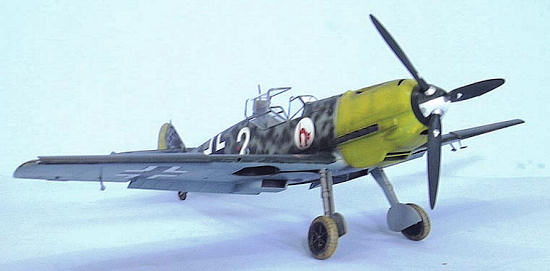 After preshading the model with flat black airbrushed on panel lines, I
painted the yellow cowling and rudder with Xtracrylix “Gelb04" which I
masked off after it was dry. The rest
was painted with Tamiya paints, using Tamiya “Light Blue” which is “Hellblau65",
“Dark Green” (RLM71) and “Black Green” (RLM70).
The fuselage sides were mottled with Xtracrylix “RLM02" and Tamiya “Dark
Green.” The spinner and prop blades
were painted “Black Green” with a white “flicker” masked off on the forward part
of the spinner.
After preshading the model with flat black airbrushed on panel lines, I
painted the yellow cowling and rudder with Xtracrylix “Gelb04" which I
masked off after it was dry. The rest
was painted with Tamiya paints, using Tamiya “Light Blue” which is “Hellblau65",
“Dark Green” (RLM71) and “Black Green” (RLM70).
The fuselage sides were mottled with Xtracrylix “RLM02" and Tamiya “Dark
Green.” The spinner and prop blades
were painted “Black Green” with a white “flicker” masked off on the forward part
of the spinner.
I was using the resin wheels from the ProModeler Bf-109G-2/G-4 kit.
The hubs were painted Tamiya Semi-Gloss Black while the tires were
painted “German Grey” and then “muddied” with the Tamiya weathering set.
When all was dry, I gave the model two coats of Xtracrylix Gloss Varnish.
Decals:
I used the EagleCals for the unit markings and national insignia, and the
kit decals for the stencils.
Everything went down easily using Miro-Sol.
I used Tamiya “smoke” for the exhaust stains and gunfire stains on the
cowling. The model then received a
coat of Xtracrylix Flat Varnish with a brushful of Tamiya “Flat Coat” mixed in.
When that was dry, the canopy was unmasked, and the landing gear, aileron
mass balances, pitot, and prop were attached.
I then attached the photoetch control wires for the rudder and posed the
canopy in the open position. I used
the Cutting Edge two-piece armored headrest just because it was there, though
the kit part would have been just fine.
This is definitely the best Bf-109E in any scale.
A well-known "expert" on another web site has recently accused the kit of
being “over-engineered” and guilty of having the fuel tank filler in the wrong
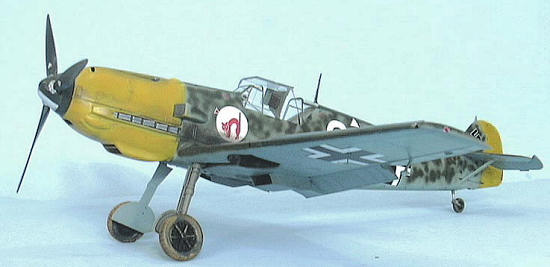 position,
but I found the kit very easy to assemble and after checking the Monogram
drawings can successfully defend the positioning of the fuel filler.
position,
but I found the kit very easy to assemble and after checking the Monogram
drawings can successfully defend the positioning of the fuel filler.
I’m sure the resinaholics will spend half the price of the kit on
aftermarket sets, but you really don’t need any of them.
I used the Cutting Edge set because I had it and to answer questions from
readers about whether it’s possible to do so, but the model would have looked
equally nice (just different) without it.
If all you ever got was the seat, it really does improve things.
It was nice to pull the parts out of their little bag and find etched on
the forward cockpit bulkhead, “Hello from Mr. Cockpit” - Scotty Battistoni
really was one of the Greats of resin parts design, and I found a great deal of
“modeling joy” in knowing I was using his cockpit.
This is the kind of kit that is easy to build, and that will look great
with some effort put into the paint job and the choice of decals.
The kit decals are nice and interesting, so one really doesn’t have to
have any of the aftermarket sheets unless there are markings to be found that
personally interest you. I am
definitely looking forward to the next Bf-109Es in this series.
Thanks to Eduard for the review
kit. Thanks to EagleCals for the
decals.
Tom Cleaver
April 2009
Copyright ModelingMadness.com
If you would like your product reviewed fairly and quickly, please
contact the editor or see other details in the
Note to
Contributors.
Back to the Main Page
Back to the Reviews Index Page 2020


 overnment
had agreed to allow German companies to participate in Spanish iron ore mining,
and would remain in service with the Ejercito del Aire until the early
1950s. In Luftwaffe service,
the Bf-109E-1 soldiered on until late 1942 on the Eastern Front after being
modified as a Jagdbomber.
overnment
had agreed to allow German companies to participate in Spanish iron ore mining,
and would remain in service with the Ejercito del Aire until the early
1950s. In Luftwaffe service,
the Bf-109E-1 soldiered on until late 1942 on the Eastern Front after being
modified as a Jagdbomber. the Heligoland Bight on
the Heligoland Bight on 


